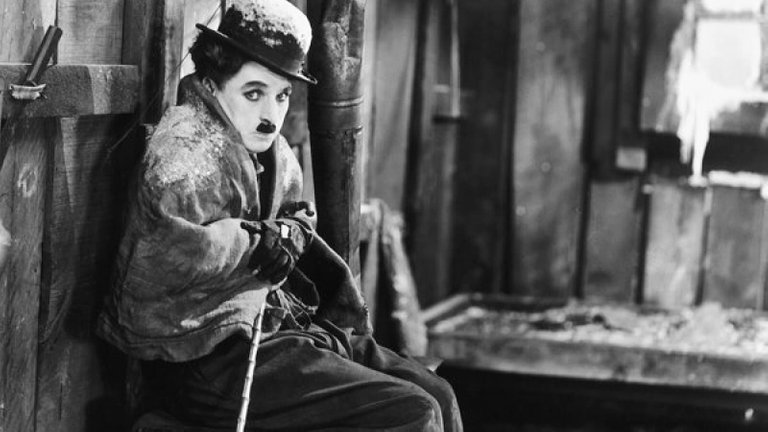Film Review: The Gold Rush (1925)

People tend to laugh the most at things they know to be true. Sir Charles Chaplin understood that and has built his international stardom on comedy based around characters and situations everyone could relate to. And even when his stories were extraordinary, they were inspired by real events, like in the case of The Gold Rush, 1925 adventure comedy which is Chaplin’s most iconic work and often considered to be among the best silent films ever made.
The film is set in Alaska during the famous Klondike Gold Rush in 1890s. Chaplin again appears in the role of Tramp or the unnamed protagonist, here credited in intertitles as “the Lone Prospector”. He has joined tens of thousands of people who arrived in Alaskan wilderness to seek fortune only to be met with freezing cold, hunger, predatory animals and even more predatory human beings. During the blizzard, Lone Prospector stumbles into cabin inhabited by Black Larsen (played by Tom Murray), a wanted criminal. Another person who gets into cabin is Big Jim McKay (played by Mack Swain), prospector who actually struck gold. Trio is forced to stay in cabin until storm subsides, but when they run out of supplies Black Larsen is chosen by a lot to go out and try getting aid. Remaining two barely survive before arrival of black bear brings them necessary amounts of food and later part ways. Big Jim is attacked and injured by Black Larsen and, as a result, forgets the location of his claim. Lone Prospector gets into one of the boomtowns where he tries to earn his living through odd jobs. There he meets and falls in love with beautiful showgirl Georgia (played by Georgia Hale) who doesn’t think much of him but nevertheless wants to make Jack Cameron (played by Malocolm Waite), her abusive suitor, jealous.
Chaplin got the idea for the film during the visit to Pickfair, home of his friends and colleagues Mary Pickford and Douglas Fairbanks. He noticed a famous photograph depicting hundreds of prospectors ascending up the mountain towards Chilkoot Pass in order to get to the gold deposits of Klondike. The scene is ultimately reconstructed in the film’s opening, which was being shot in the mountains of Northern California. Chaplin, who had originally wanted to film The Gold Rush on location, ultimately found that dependence of weather and logistical requirement were making the production too complicated and opted for simple alternative of reconstructing 1890s Alaska wilderness in Los Angeles studios. His decision proved to be correct and the production, despite coinciding with one of the messier chapters of Chaplin’s private life – scandalous divorce from Lita Grey, young actress who was originally to play Georgia and was ultimately replaced with Georgia Hale, with whom Chaplin actually had romantic relationship on the set. Chaplin has shown himself to be an immensely talented film maker. Despite not having a strong plot, The Gold Rush is well-paced and cinematography by Ronald Totheroth is quite impressive for 1920s standards. The film is still exciting and entertaining as it was nearly a century ago.
But the most valuable thing about The Gold Rush is its script and the way story matches perfectly Chaplin’s iconic character of The Tramp. In this film, like in many other, Tramp seeks what most of film’s audience wants and, like most of film’s audience, encounters terrible impediments of his path, often based on his low social status. In case of The Gold Rush those challenges are quite extreme and, on occasion, the film is actually very dark in tone. People in film actually die and even when they live they experience hunger and madness; even the more quiter section of the film contains the scene where protagonist is subjected to cruel trickery. Thankfully, Chaplin knows how to wrap this darkness into easily digestible comedy and make audience laugh in the scenes that would otherwise be horrifying. That includes protagonist being oblivious over the fact that he is stalked by hungry bear or the shoe eating scene, one of the most iconic and memorable images of silent cinema. Chaplin at the end feels compelled to counter that kind of darkness with the happy ending that some critics might find to be too sentimental and unrealistic.
Critics at the time of premiere were mostly positive and the audience was ecstatic. The Gold Rush became the most commercial successful comedy of silent era and one of the most successful five silent films ever. It confirmed Chaplin’s status as great entertainer and one of the greatest film makers of its time. In 1942 Chaplin reissued new version of the film, slightly changing the ending and adding his own music and narration. By 1950s status of The Gold Rush as one of the greatest films ever made was well entrenched and it easily famous critics’ polls and similar surveys. Those who watch this simple but masterfully done piece of film making today are likely to agree with such opinions.
RATING: 8/10 (+++)
Blog in Croatian https://draxblog.com
Blog in English https://draxreview.wordpress.com/
Leofinance blog https://leofinance.io/@drax.leo
Cent profile https://beta.cent.co/@drax
Minds profile https://www.minds.com/drax_rp_nc
Uptrennd profile https://www.uptrennd.com/user/MTYzNA
Unstoppable Domains: https://unstoppabledomains.com/?ref=3fc23fc42c1b417
Hiveonboard: https://hiveonboard.com?ref=drax
Bitcoin Lightning HIVE donations: https://v4v.app/v1/lnurlp/qrcode/drax
Rising Star game: https://www.risingstargame.com?referrer=drax
1Inch: https://1inch.exchange/#/r/0x83823d8CCB74F828148258BB4457642124b1328e
BTC donations: 1EWxiMiP6iiG9rger3NuUSd6HByaxQWafG
ETH donations: 0xB305F144323b99e6f8b1d66f5D7DE78B498C32A7
